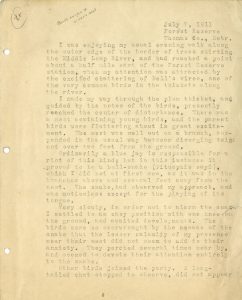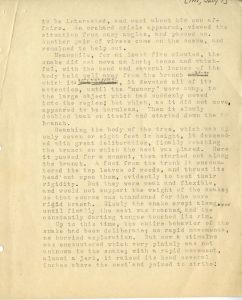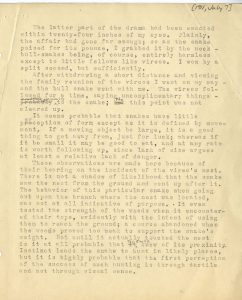Great Nebraska
Naturalists and Scientists
Frank H. Shoemaker
Forest Reserve, Thomas County
July 7, 1911
Forest Reserve
Thomas Co., Nebr.
I was enjoying my usual evening walk along the outer edge of the border of trees skirting
the Middle Loup River, and had reached a point about a half mile east of the Forest Reserve station, when
my attention was attracted by the excited chattering of Bell’s vireo, one the very common birds in the thickets along the river.
I made my way through the plum thicket, and, guided by the notes of the birds, presently
reached the center of disturbance. There was a nest containing young birds, and the
parent birds were fluttering about in great excitement. The nest was well out on a
branch, suspended in the usual way between diverging twigs not over two feet from
the ground.
Ordinarily a blue jay is responsible for a riot of this kind ; but in this instance it proved to be a bull-snake. (Pituophis sayi), which I did not at first see, as it was in the branches above and several feet
away from the nest. The snake had observed my approach, and was motionless except
for the playing of its tongue.
Very slowly, in order not to alarm the snake, I settled to an easy position with one
knee on the ground, and awaited developments. The birds were so overwrought by the
menace of the snake that the lesser calamity of my presence near their nest did not
seem to add to their anxiety. They perched several times near by, and seemed to devote
their attention entirely to the snake.
Other birds joined the party. A long-tailed chat stopped to observe, did not appear
to be interested, and went about his own affairs. An orchard oriole appeared, viewed the situation from many angles, and passed on. Another pair of vireos came on the scene, and remained to help out.
Meanwhile, for at least five minutes, the snake did not move an inch; tense and watchful,
with the head and several inches of the body held well away from the branchaboutalong, which it, was twanedbody was posed,it devoted all of its attention, until the “memory” wore away, to the large object
which had suddenly moved into the region; but which, as it did not move, appeared
to be harmless. Then it slowly doubled back on itself and started down the branch.
Reaching the body of the tree, which was up only seven or eight feet in height, it
descended with great deliberation, finally reaching the branch on which the nest was
placed. Here is paused for a moment, then started out along the branch. A foot from
the trunk it encountered the top leaves of weeds, and thrust its head out upon them,
evidently to test their rigidity. But they were weak and flexible, and would not support
the weight of the snake; so that course was abandoned for the more rigid branch. Slowly
the snake crept along, until finally, the nest was reached, and the constantly darting
tongue touched its rim.
Up to this time, the entire behavior of the snake had been deliberate; no rpid movement,
no hurried exploration. But now a stimulus was encountered which very plainly was
not unknown to the snake; with a rapid movement, almost a jerk, it raised its head
several inches above the nest and poised to strike!
The latter part of the drama has been enacted within twenty-four inches of my eyes.
Plainly, the affair had gone far enough; so as the snake poised for its pounce, I
grabbed it by the neck — bull-snakes being, of course, entirely harmless except to
little fellows like vireos. I won by a split second, but sufficiently.
After withdrawing a short distance and viewing the family reunion of the vireos I
went on my way — and the bull-snake went with me. The vireos followed for a time,
saying uncomplimentary things — probablypresumably to the snake; butthe this point was not cleared up.
It seems probable that snakes have little reer perception of form except as it is defined by movement. If a moving object be large,
it is a good thing to get away from, just for luck; whereas if it be small it may
be good to ear, and at any rate is worth following up, since lack of size argues at
least a relative lack of danger.
These observations are made here because of their bearing on the incident of the vireo’s
nest. There is not a shadow of likelihood that the snake saw the nest from the ground
and went up after it. The behavior of this particular snake when going out upon the
branch where the nest was located, was not at all indicative of purpose. It even tested
the strength of the weeds when it encountered their tops, evidently with the intent
of using them to reach the ground; a course abandoned when the weeds proved too weak
to support the snake’s weight. Not until it actually touched the nest is it at all
probably that itthe snake knew of its proximity. Instinct leads the snake to hunt in likely places, but it
is highly probable that the first perception of the success of such hunting is through
tactile and not through visual sense.


